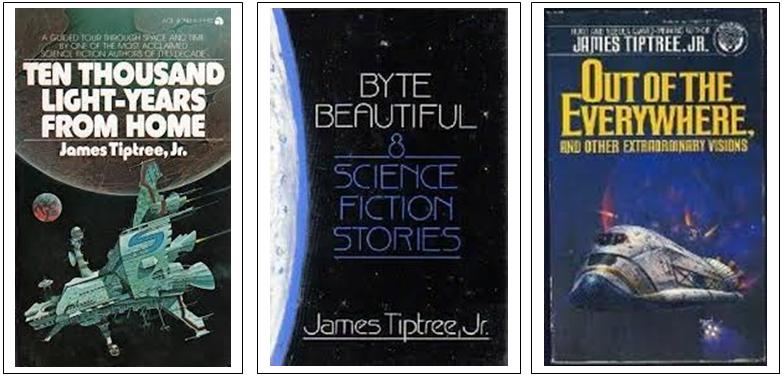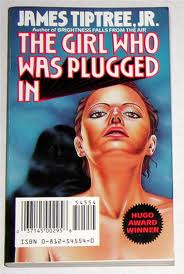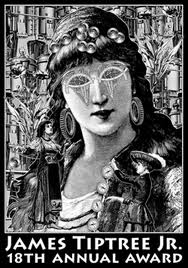No. 16 – 2013 May12 – Alice Bradley Sheldon, The Screwfly Solution, and the Secret Life of a CIA Operative.
It took a long time before the truth about Alice came out.

In 1921-22, Alice, as Alice Bradley, traveled in central Africa with a pith helmet on her head and mingled with the elephant herds with her naturalist father. She married William Davey at nineteen (1934), then divorced him (1941). She wrote, as an art critic, for the Chicago Sun during 1941-42. 1942 saw her enlist in the U.S. Army, performing her duty for the war effort in the Army Air Services with a stint in photographic intelligence work. Promoted to major, in this work she “felt she was among free women for the first time.”
She remarried to Huntington D. Sheldon in 1945, and, finishing an assignment in Paris, was discharged from the service in 1946 and started a small business with her husband. She published her first piece of writing in The New Yorker called “The Lucky Ones.”
In 1952, she and her husband were invited to join the C.I.A. and became part of The Company. In 1954-55, she was an operative in the Near East. In 1955, she resigned from the agency. She had learned to become, one could imagine, quite adept in the art of deception. If nothing else, she was self-disciplined enough to keep her mouth comfortably shut for many years.


In 1968, she began writing science fiction under the pseudonym of James Tiptree, Jr., initially to protect her academic reputation after gaining a doctorate in psychology in 1967. Many associates, and fellow travelers in science fiction, came to believe she was a he … and possessed of a very masculine mind. James, it was believed, had that special ability, so rare in men, to really understand women. She occasionally used the name Raccoona Sheldon for some works, but James Tiptree, Jr. gathered a loyal following of curious fans who wanted to know more about him. She demurred and resisted queries about James’ personal life. Pictures remained unavailable and no one had ever met James. All fans, and even friends who exchanged close and often revealing letters, ever knew was he received correspondence through his P.O. Box 315 in McLean, Virginia.
The Screwfly Solution is a marvelous story in the best traditions of science fiction. She won a 1977 Nebula Award for this work in the novelette category, not as James Tiptree, Jr., however, but under her pseudonym of Raccoona Sheldon.

The story in summary: the plot exposition comes from an exchange of correspondence between a scientist, working on parasite eradication in Columbia, and his wife, living in the U.S., living in fear of a spreading epidemic of murders against women. Mixed up in this scenario is The Sons of Adam who are advocating a religion-based, male chauvinism, blaming women for all humankind’s evils. As the murders increase, the male proponents of this religion are evicting women from areas they control. Male sexual impulses are becoming violent impulses; the murderers construct elaborate rationalizations for their misogynistic behavior as the situation spirals out of control. The scientist suspects he is succumbing to this biological epidemic, when, to his shock, his daughter arrives. He kills her, then overcome with grief, he kills himself. This epidemic of spreading femicide kills off most of the world’s population of women. The adult men switch to murdering boys. The scientist’s wife flees to Canada, hoping to evade the disease that began spreading out of the tropics.
In the end, the scientist’s wife determines that the source of the disease is alien; it is an agent of biologic warfare intentionally let loose upon the Earth by extraterrestrials who want the planet for their own uses. This story was adapted for television, directed by Joe Dante for Showtime and premiered 8-Dec-2006. (Ed. Note: The film, part of the Masters of Horror series, can be watched on Hulu.)
My first Alice read came from a short story collection; The Year’s Best Science Fiction: Third Annual Collection (Gardner Dozois, ed.).
In the short story, “The Only Neat Thing To Do” (by James Tiptree, Jr.) a young woman with an aptitude for celestial navigation, and a passion for stellar exploration, is given her first starship by her wealthy parents.
O Yes! And she’s a teenager. So she doesn’t use it to run around with her friends in-system, but has custom built long-range tanks installed and heads out to the fringe of explored space for a chance at grabbing a little glory in the annals of space exploration. When she arrives at a newly constructed outpost, the local frontier officials glance nervously at each other. But the young woman’s smile and clever remarks reassure them. It might be a bit unusual, but it’s just a lark and she’s level-headed enough to stay safe.
But then she’s into the great deep … and unexpected events overtake her. She gets more than she anticipated.
Well … I’ll be nice and will skip the complete plot spoiling of the story this time. I think I’ll let you chase it down and finish the read yourself. I will say that the young woman does, however, make her mark on history.

Alice has several fun short story collections worth chasing down: Ten Thousand Light-Years from Home (1973), Warm Worlds and Otherwise (1975), Star Songs of an Old Primate (1978), Out of the Everywhere and Other Extraordinary Visions (1981), Byte Beautiful: Eight Science Fiction Stories (1985).

The Girl Who Was Plugged In uses one of my favorite themes: corporate malfeasance. Even without advertising, corporations use celebrities and product placement to control consumers. The protagonist, Philadelphia Burke, is a failed suicider that comes to the attention of corporate scouts. Choosing to be a REMOTE (cybernetically connected to another being), Burke controls Delphi, a beautiful body sans cerebellum. On the surface, Delphi is a soap opera actress, but corporate uses Delphi as a role model for consumers. Burke falls in love, but when her lover uncovers Delphi is controlled remotely, he is incensed over Delphi’s presumed enslavement. He breaks into the remote laboratories, and sees a deformed girl wired into the machinery controlling Delphi. When he rips out Delphi’s implants, he kills Burke, unaware that Delphi has no mind.
There are several themes in this book; a distrust of corporations, consumerism, and celebrity role models. This is an excellent example of an early form of cyberpunk. Alice is often cited as a progenitor author in the discussion of the emerging genre.
I find it humorous that in 1975, in an introduction to a book of Tiptree’s short stories, Robert Silverberg, who was considered a close friend of James Tiptree Jr.’s, asserted that: “It has been suggested that Tiptree is female, a theory that I find absurd, for there is to me something ineluctably masculine about Tiptree’s writing.”
Tiptree contributed in writing symposium as a nominally “sensitive man.” The feminist science fiction writer, Joanna Russ, who was also a letter-writing friend of Alice’s, remarked that Tiptree had ideas “no woman could even think, or understand, let alone assent to.”
Alice once said: “A male name seemed like good camouflage. I had the feeling that a man would slip by less observed. I’ve had too many experiences in my life of being the first woman in some damned occupation.”

Alice finally betrayed herself. In letters she had often been revealing about intimate details of her life and so it happened that Tiptree revealed that his mother had died. A few of Tiptree’s friends, who checked Chicago newspaper obituaries, discovered that Mary Hastings Bradley’s only survivor was: Alice Bradley Sheldon. The jig was up.
On 19-May-1987, she was 71, her husband was 84. He was an invalid and she made the decision to end his life and then take her own.
Julie Phillips’ biography about Alice: James Tiptree Jr.:The Double Life of Alice B. Sheldon, is probably the best biography (currently, anyway) about Alice.

And as a last, but by no means minor, point; let us remember that one of Alice’s legacies is the James Tiptree, Jr. Literary Award.











